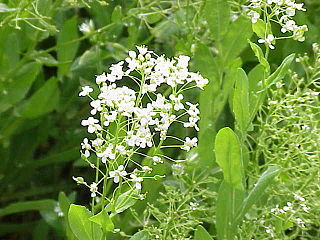
Lepidium draba, also known as whitetop, hoary cress, or Thanet cress, is a rhizomatous perennial flowering plant in the family Brassicaceae. It is native to western Asia and southeastern Europe and has been widely introduced elsewhere.

Draba verna, common whitlowgrass, is a species of plant in the cabbage family. It is a small spring-flowering annual which is widely dispersed around the world, and which is found on walls, pavements and patches of bare ground. It has a complex taxonomy which is not yet fully elucidated.

Draba albertina is a species of flowering plant in the mustard family known as the Arc dome draba,slender draba or slender whitlow-grass.

Draba aureola is a species of flowering plant in the family Brassicaceae known as the Mt. Lassen draba or Mt. Lassen whitlow-grass. This plant is native to the Cascade Range of western North America, where it grows at elevations above 2000 meters. This is usually a perennial plant found growing in rocky areas such as volcanic cliffs and scree. It has one or more short, stout stems which are covered in stiff hairs. The leaves grow in a dense basal clump at the ground. They are fat and fleshy and covered in a carpetlike coat of stiff, light-colored, branching hairs. The stem may be erect above the clump of leaves or its inflorescence may rest directly upon them. The spherical or club-shaped inflorescence may have up to 80 small, yellow flowers packed densely in it, each petal about 5 millimeters wide. The fruit is a wavy-edged, hairy silique about a centimeter long and half a centimeter wide.
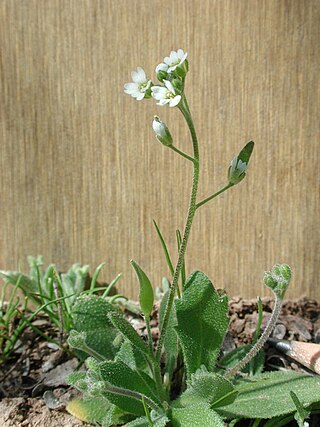
Draba cuneifolia is a species of flowering plant in the family Brassicaceae known as the wedgeleaf draba or wedgeleaf whitlow-grass. This annual plant is native to the southern half of North America where it grows in open, rocky fields and other disturbed areas. The plant forms a basal cluster of leaves, which are thick, widely toothed, and coated in stiff hairs. It bolts one or more erect stems which may approach 40 centimeters in maximum height. Each hairy stem bears an inflorescence of up to 75 small white flowers that continue at intervals down the stem as the stem grows in height. This family and its plants are easy to identify with its 4 petals and 4 sepals arranged like a "cross", either in an "X" or "H" shape, thus the name "Cruciferae". Mustards have 6 stamens usually 4 are taller and 2 are shorter. Fruits are either a long thin silique or short often rounded silicle.
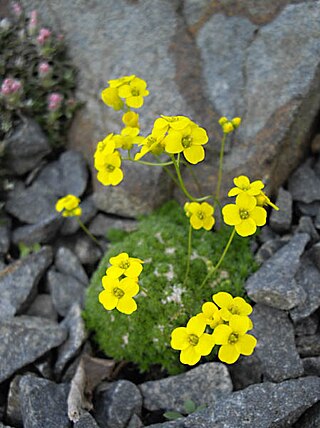
Draba densifolia is a species of flowering plant in the family Brassicaceae known by the common names Alpine Whitlow-Grass and denseleaf draba. This small perennial is native to western North America, where it is found in mountain environments above 2000 meters from California to Alaska to Wyoming. The plant forms cushion-like mats of small fleshy, hairy, pointed leaves in rocky crevices and on slopes. If it bolts a stem it is no taller than 15 centimeters. The flowers open in an obvious inflorescence of a few tiny blooms at times, but often appear as a layer on the surface of the mat of tiny leaves. The flowers are bright yellow with petals just a few millimeters wide. The fruit is a flat podlike silique less than a centimeter long. Grows in alpine rocky slopes, barren outcrops.
Draba subumbellata is a species of flowering plant in the family Brassicaceae known by several common names, including parasol draba, mound draba, and White Mountains cushion draba. This small perennial plant is native to the White Mountains which straddle the California-Nevada state line and the Inyo Mountains nearby. It lives on barren rocky scree above 3000 meters.
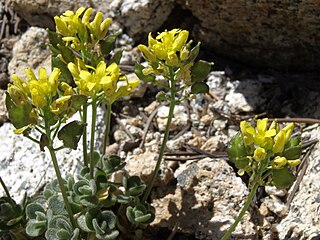
Draba asterophora is a species of flowering plant in the family Brassicaceae known by the common names Lake Tahoe draba or Tahoe Whitlow-grass. This rare plant is known only from the Mount Rose and Slide Mountain areas of the northern Carson Range in extreme western Nevada, in and just outside of the Lake Tahoe drainage basin. It is a squat perennial herb which forms small mats in rocky habitat in the alpine climate of the high mountains. It forms a basal patch of thick, hairy oval leaves up to 1.5 centimeters long. A small, erect inflorescence arises from the patch bearing several yellow mustard-like flowers. The fruit is a flat, wavy silique which is oval in shape, somewhat membranous, and up to 1.5 centimeters long. It contains several flat, round seeds with wide wings along the edges.
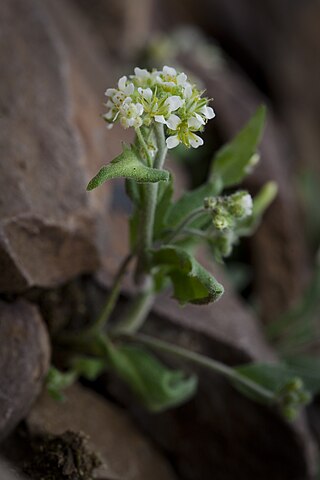
Draba breweri is a species of flowering plant in the family Brassicaceae known by the common names cushion draba, lanceleaf draba, Brewer's draba, and Brewer's whitlow grass. With Draba cana now considered a variety of this species, it is distributed throughout parts of northern and western North America, including much of Canada and the western United States. The less widespread var. breweri is limited to mountainous California and western Nevada.
Draba sharsmithii is an uncommon species of flowering plant in the family Brassicaceae known by the common names Mt. Whitney draba and Sharsmith's draba.

Castilleja septentrionalis is a species of Indian paintbrush known by several common names, including northern paintbrush, sulfur paintbrush, and pale painted cup. There is taxonomic disagreement as to if it is one species widely distributed in mountain and alpine environments of North America or if there is a second species, Castilleja sulphurea, in the Rocky Mountains.
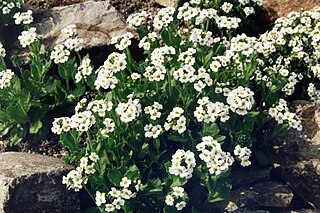
Draba fladnizensis is a species of plant in the family Brassicaceae known by the common names arctic draba, Austrian draba, and white arctic whitlow-grass. It has a circumpolar distribution, occurring throughout the northern latitudes of the Northern Hemisphere. It is present in Europe, Asia, and North America from Alaska across northern Canada to Greenland. Its distribution extends south through the higher elevations in the Rocky Mountains to Colorado and Utah. It is common and widespread in the Canadian Arctic Archipelago, occurring on several Arctic islands including Baffin, Devon, and Ellesmere Islands. It is named after the Austrian village of Flattnitz, in the Gurktaler Alpen.
Draba burkei is a species of flowering plant in the family Brassicaceae known by the common names snowbasin draba and Burke's draba. It is endemic to Utah in the United States, where it is known from Box Elder, Cache, Morgan, and Weber Counties. This plant was considered a variety of Draba maguirei until 2004, when it was elevated to species status.
Draba exunguiculata is a species of flowering plant in the family Brassicaceae known by the common names clawless draba and Grays Peak draba. It is endemic to Colorado in the United States.

Draba globosa is a species of flowering plant in the family Brassicaceae known by the common names beavertip draba, round-fruited draba, and rockcress draba. It is native to the western United States, where it occurs in Idaho, Montana, Utah, Wyoming, and possibly Colorado.
Draba graminea is a species of flowering plant in the mustard family known by the common names Rocky Mountain draba and San Juan Whitlow-grass. It is endemic to the state of Colorado in the United States, where it is limited to the San Juan Mountains.
Physaria fremontii is a species of flowering plant in the family Brassicaceae known by the common name Fremont's bladderpod. It is endemic to Wyoming in the United States, where it occurs only in and around the Wind River Range in Fremont County.
Castilleja kerryana is a species of flowering plant in the family Orobanchaceae. It is commonly known as Kerry's Indian paintbrush or Kerry’spaintbrush. It was formally described in 2013 and so far it is known only from a small population in the state of Montana, in the Northwestern United States.
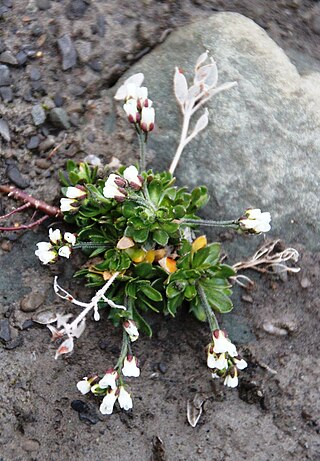
Draba norvegica is a species of flowering plant in the mustard family (Brassicaceae) know by the common names Norwegian draba and Norwegian whitlow grass.

Saussurea weberi is a species of flowering plant in the genus Saussurea, the saw-worts. It is endemic to the U.S. states of Montana, Colorado and Wyoming and considered imperiled to vulnerable globally.














